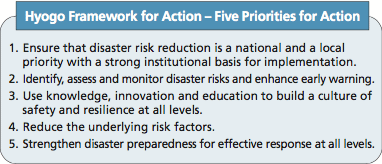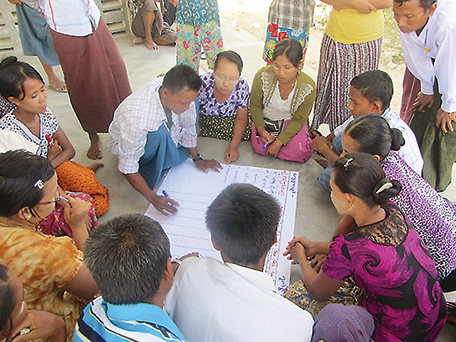ODA Topics 03
International Cooperation for Disaster Risk Reduction
(The Third UN World Conference on Disaster Risk Reduction)
The threat of natural disasters has only grown more serious in recent years, as exemplified by the Great East Japan Earthquake and flooding in Thailand in 2011, Hurricane Sandy in New York in 2012, and Typhoon Haiyan (known as Typhoon 30 in Japan and Typhoon Yolanda in the Philippines) in 2013. Natural disasters do not just threaten lives and property, they also pose a great risk to the achievements made over many years in the field of development. Globally, an average of more than 200 million people experience a natural disaster every year, and 90% are citizens of a developing country. The socially disadvantaged including women, children, the elderly, and the disabled tend to be at greater risk to suffer serious damage from disasters. Furthermore, in a globalized world in which masses of people, goods and capital are moving across national borders, natural disasters impact not only the regions they hit, but have immediate effects on countries around the world as they disrupt supply chains. The average economic damage from natural disasters is said to exceed $100 billion every year. For developing countries, natural disasters are a major impediment to poverty reduction and sustainable development.
As a country with a long history of experience with natural disasters, Japan is undertaking a variety of disaster risk reduction initiatives in the international community. One such initiative is the hosting of the UN World Conference on Disaster Risk Reduction. The UN World Conference on Disaster Risk Reduction is a conference organized by the UN for the establishment of an international disaster risk reduction framework. Its first meeting was convened in Yokohama in 1994. The second was held in Kobe in 2005, resulting in the adoption of the Hyogo Framework for Action 2005-2015. Within that Framework, participants agreed on the five priorities for action that countries, international organizations and others should strive to realize (listed below). Japan is working along with all of the other countries for the implementation of disaster risk reduction measures based on this framework.

In March 2015, the Third UN World Conference on Disaster Risk Reduction will be held in Sendai, a city that experienced the Great East Japan Earthquake. The meeting is scheduled to establish a post-2015 framework for disaster risk reduction after the end of the Hyogo Framework for Action 2005-2015. In the meeting, Japan will not only aim for the establishment of an effective post-2015 framework that can also respond to new issues, such as urbanization and climate change, but will also try to reflect its own experiences with disasters and knowledge of disaster risk reduction in the next framework. As a country that has supported the empowerment of women, Japan will also strive to integrate the perspective of women into the framework. Furthermore, Japan is promoting the mainstreaming of disaster risk reduction by including perspectives on disaster risk reduction into all of its development policies and plans. The Third UN World Conference on Disaster Risk Reduction is seen as an excellent opportunity to promote the mainstreaming of disaster risk reduction.
Approximately 5,000 people involved in disaster risk reduction, including country representatives such as heads of state and cabinet members, representatives of international organizations, and people from internationally recognized NGOs are expected to attend the Third UN World Conference on Disaster Risk Reduction. With the participation by members of the general public, the meeting will likely draw over 40,000 participants in total. In addition to conference meetings, side events will be held to showcase the progress of reconstruction in the places ravaged by the Great East Japan Earthquake, including visits to the affected areas, which have been attracting keen interest from many countries and international organizations.

Disaster risk reduction workshop was conducted in a community, as part of the Project on Establishment of End-to-End Early Warning System for Natural Disaster. (Photo: JICA)
During a speech at the UN Climate Summit in September 2014, Prime Minister Shinzo Abe emphasized Japan's contributions to the global community through international cooperation in the field of disaster risk reduction enabled by harnessing its accumulated knowledge and expertise in the field. He also called on Summit participants to attend the Third UN World Conference on Disaster Risk Reduction. As the threat of natural disasters increases and the importance of disaster risk reduction continues to grow, the international community is increasingly expecting Japan, a country which has overcome a number of disasters and possesses a wide range of knowledge and technology for disaster risk reduction, to play a vital role in reducing risks from natural disasters. Japan hopes to contribute even further to help countries and communities across the world become more resilient to disasters through the hosting of the Third UN World Conference on Disaster Risk Reduction.
